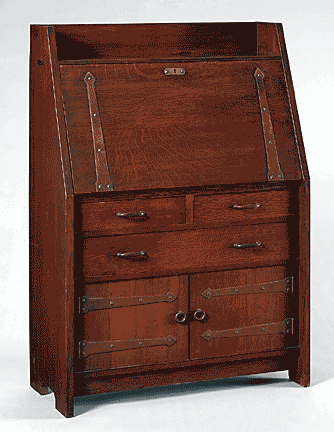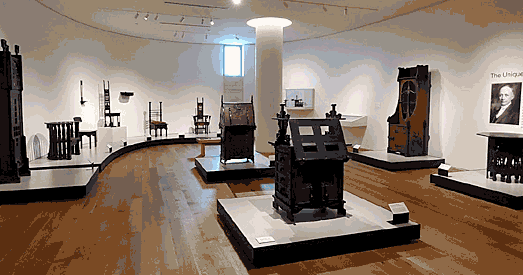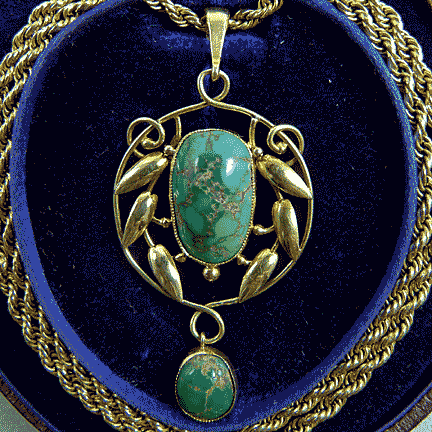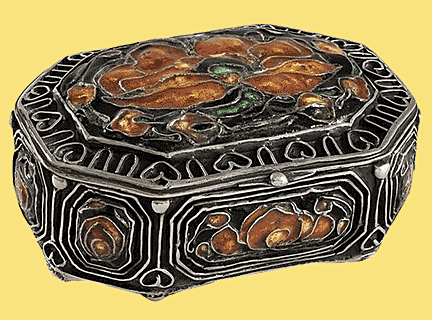A Museum of Arts & Crafts
by Bob Brooke
The
Museum of the American Arts and Crafts Movement is the only museum
dedicated exclusively to the American Arts and Crafts Movement. Founded
in St. Petersburg, Florida, by local philanthropist and collector Rudy
Ciccarello, it showcases the ideals of the Arts & Crafts Movement.

Arts and Crafts designers sought to reform both decorative design and
daily life, creating objects that were beautiful and functional. The
goals of the Movement— simplicity in design, honesty in materials, hand
craftsmanship, and depicting the natural world—are still valued today.
 The
Museum’s collection represents the works of some of the most important
artists of the Movement. The collection consists of outstanding, rare,
and one-of-a-kind examples of furniture, pottery, ceramic tiles and
architectural faience, metalwork, woodblocks, fine art, lighting,
textiles, and leaded glass, created between 1890 and 1930. The
Museum’s collection represents the works of some of the most important
artists of the Movement. The collection consists of outstanding, rare,
and one-of-a-kind examples of furniture, pottery, ceramic tiles and
architectural faience, metalwork, woodblocks, fine art, lighting,
textiles, and leaded glass, created between 1890 and 1930.
The spirit of reform and the belief that traditional craftsmanship could
enhance a society overcome by industrialization permeated the Arts &
Crafts Movement, both here and abroad. Its founders believed that
simplicity in style and honesty in construction had the power to
transform everyday objects into ones of beauty, enhancing the lives of
both maker and user. Artisan furniture makers of the Arts and Crafts
Movement interpreted this philosophy in sturdy oak and rich mahogany, as
well as chestnut, cedar, elm, cherry, even cypress. With the addition of
hammered iron straps and handles, inlaid metals and beveled glass,
tooled leather and ceramic tiles, the objects they produced were
diverse, useful, and, above all, beautiful.
Artisan metalsmiths sought to move away from the Victorian excess of
ornamentation and design items that would be useful but also embody
“dignity and grace,” in accordance with the tenets of the Arts and
Crafts Movement. Metalworkers made the dignity of labor and the value of
good design visible in hammered copper, molded bronze, and cast silver.
They created vases, bowls, and candlesticks to andirons, trays, and
bookends, as well as artistic jewelry.

At the turn of the 20th century, Americans became infatuated with art
pottery. Professional and amateur ceramists across the country—many of
them women—sought to create works that were both beautiful and
functional. Proponents of the Movement responded to the crassness of
mechanized society by insisting on beauty in common things. They saw
manual labor as something positive and having redemptive value. The Arts
and Crafts Movement appealed to right-minded members of society who
wished to live in an environment that was elevated both morally and
aesthetically.

The Museum’s collection also features examples of late 19th- to early
20th-century Arts and Crafts ceramics from some of the most significant
potteries in the United States— the Grueby and Paul Revere potteries in
Boston, the Rookwood Pottery and Gates Potteries in the Midwest, Newcomb
Pottery in New Orleans, and the Van Briggle and Rhead potteries in the
West.
 Jewelry
design underwent considerable change around the turn of the 20th
century. In reaction against Victorian-era clothing, fashions for women
became less rigid, enabling artists to create simpler jewelry designs to
complement them. Jewelers looked to nature as inspiration for new
designs. An art jewelry movement emerged in both the U.S. and Britain. Jewelry
design underwent considerable change around the turn of the 20th
century. In reaction against Victorian-era clothing, fashions for women
became less rigid, enabling artists to create simpler jewelry designs to
complement them. Jewelers looked to nature as inspiration for new
designs. An art jewelry movement emerged in both the U.S. and Britain.
The rare and unique pieces in the Museum’s jewelry collection are
examples of the spirit of reform present in the Movement. No matter
where it developed, art jewelry shared a strong reaction against ornate
Victorian and Edwardian styles that prioritized expensive gemstones and
metals, favoring instead simpler and more artistic designs inspired by
nature. Jewelers, selecting materials for their natural beauty instead
of value, preferred silver and copper over gold and platinum, adorned
with semi-precious or non-precious materials such as moonstone,
amethyst, turquoise, paste stones, baroque pearls, enamel, and horn.
 In
response to poor workmanship and mass production, artisans took pride in
creating pieces that revealed the hand of
the
maker. The shared interest in craftsmanship and beauty aligned these
jewelers closely with the spirit of the larger Arts and Crafts Movement.
The reformist mindset of the Movement also made it possible for women to
become jewelers for the first time. The jewelry collection includes work
by notable American, British, and European women and men such as Arthur
and Georgina Gaskin, Mrs. Charlotte Newman, John Pontus Petterson,
Elizabeth Copeland, Archibald Knox, the Kalo Shop, and Tiffany & Co.
Through necklaces, brooches, and buckles as well as boxes, bowls, and
dining utensils, the collection offers insight into how people of the
time created their identities with the objects they chose for personal
adornment. In
response to poor workmanship and mass production, artisans took pride in
creating pieces that revealed the hand of
the
maker. The shared interest in craftsmanship and beauty aligned these
jewelers closely with the spirit of the larger Arts and Crafts Movement.
The reformist mindset of the Movement also made it possible for women to
become jewelers for the first time. The jewelry collection includes work
by notable American, British, and European women and men such as Arthur
and Georgina Gaskin, Mrs. Charlotte Newman, John Pontus Petterson,
Elizabeth Copeland, Archibald Knox, the Kalo Shop, and Tiffany & Co.
Through necklaces, brooches, and buckles as well as boxes, bowls, and
dining utensils, the collection offers insight into how people of the
time created their identities with the objects they chose for personal
adornment.
The later 19th and early-20th century color woodblock prints in the
collection represent a broad range of styles and sensibilities. The most
important names working in the medium at the time, including Arthur
Wesley Dow, Gustave Baumann, Margaret Patterson, William Seltzer Rice,
Frances Hammell Gearhart, Edna Boies Hopkins, Eliza Draper Gardiner, and
J. B. O. Nordfeldt, can be viewed in the displays.
<
Back to More Antiques to View
Next
Article >
|
